Abstract
OBJECTIVE--Activated T lymphocytes are involved in the pathogenesis of scleroderma (systemic sclerosis, SSc); such cells rapidly divide in vivo and are thus theoretically subject to random mutation more frequently than resting cells. To study whether SSc is associated with rapidly expanding T cell clones the frequency was determined of in vivo mutated T cells (MF) at the hypoxanthine guanine phosphoribosyl transferase (hprt) gene in the peripheral blood from patients with SSc. Specific clinical or serological associations were also investigated. METHODS--Peripheral blood lymphocytes from 16 healthy individuals and 20 patients with SSc were cultured using an hprt clonal assay; mutated and wild T cell clones were established to assess individual values of T cell MF. T cell clones were further expanded in vitro and their phenotype was determined by standard immunofluorescence technique. Enzyme-linked immunosorbent assays were used for simultaneous measurements of plasma levels of soluble Interleukin-2 receptors (s-IL-2R) and Intercellular adhesion molecule-1 (s-ICAM-1). RESULT--Mean (SD) value of T cell MF in patients with SSc was 2.5-fold higher than the normal mean (SD) value [10.6 (6.6) x 10(-6) v [4.4 (2.8) x 10(-6), p = 0.0007]. Eleven of 20 patients with SSc (55%) had T cell MF values greater than two SD above the normal mean value. The majority (84%) of mutated T cells had a helper/inducer, memory phenotype while 12% were cytotoxic/suppressor T cells. There was no association between T cell MF and the extent of skin involvement or the duration of Raynaud's phenomenon. High individual T cell MF values were not related to a possible concurrent immune overactivity as assessed by plasma levels of s-IL-2R and s-ICAM-1. Patients with long standing skin disease, however, had almost double T cell MF values than patients with early skin disease [(13.6 (7.4)) x 10(-6) v (7.5 (4.3)) x 10(-6), p = 0.03], suggesting that increased T cell MF in SSc may reflect an ongoing process of chronic in vivo T cell proliferation and/or prolonged survival. CONCLUSION--Increased in vivo T cell mutation in patients with SSc suggests that excessive division and/or survival of T cell clones contribute to the pathology in SSc; this approach can be used in further investigations to identify the stimulus that is triggering T cell activation in this disease.
Full text
PDF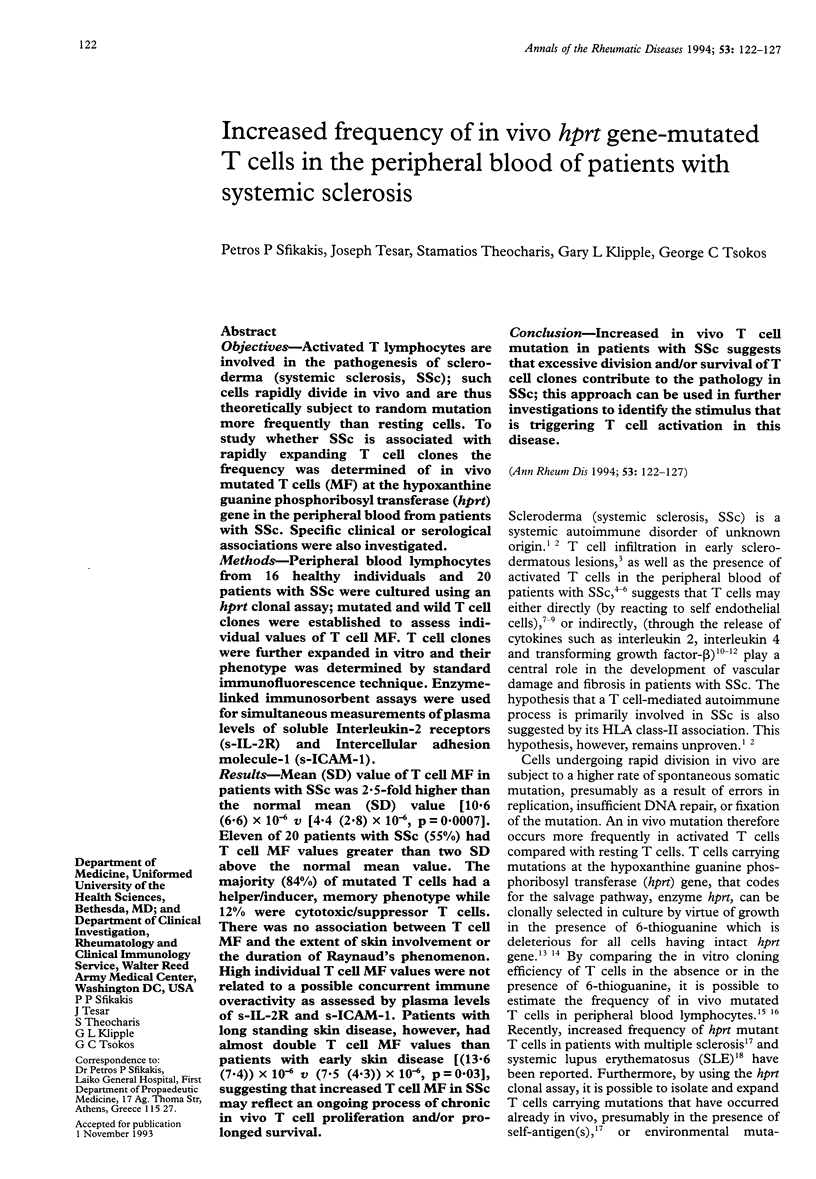
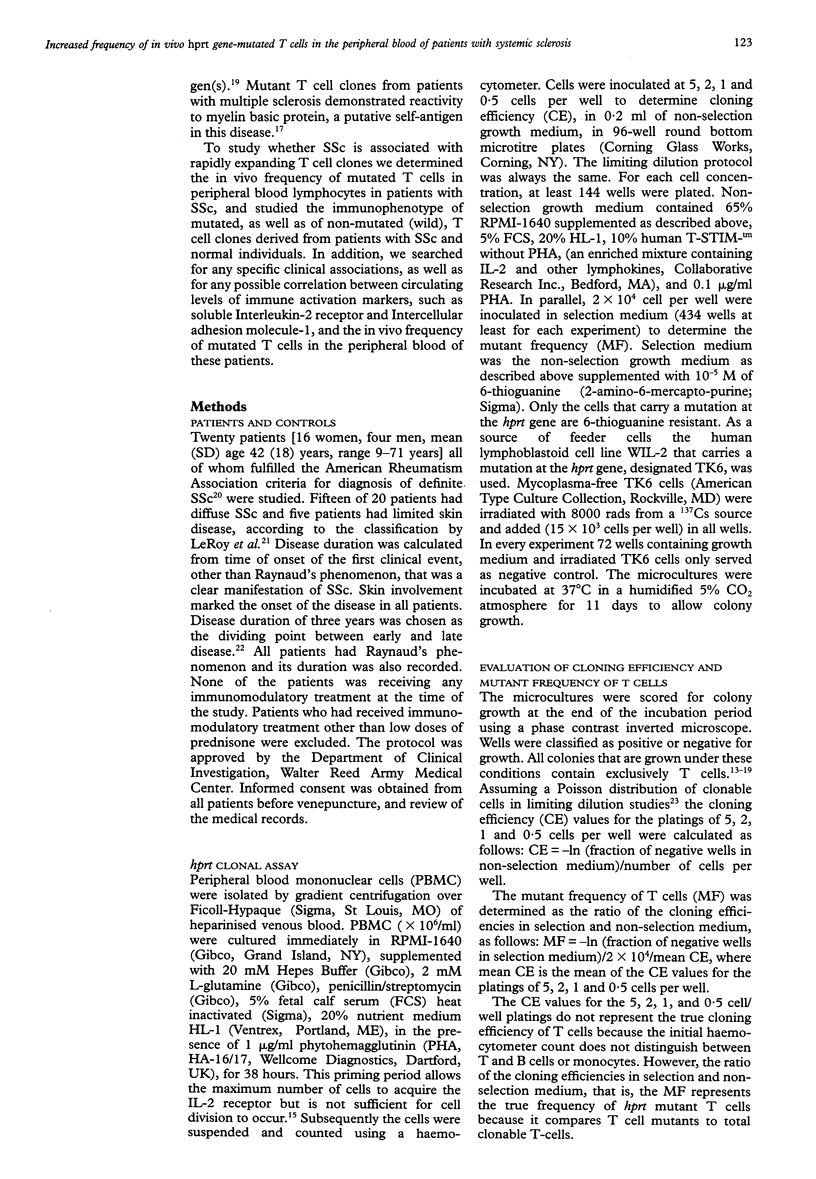
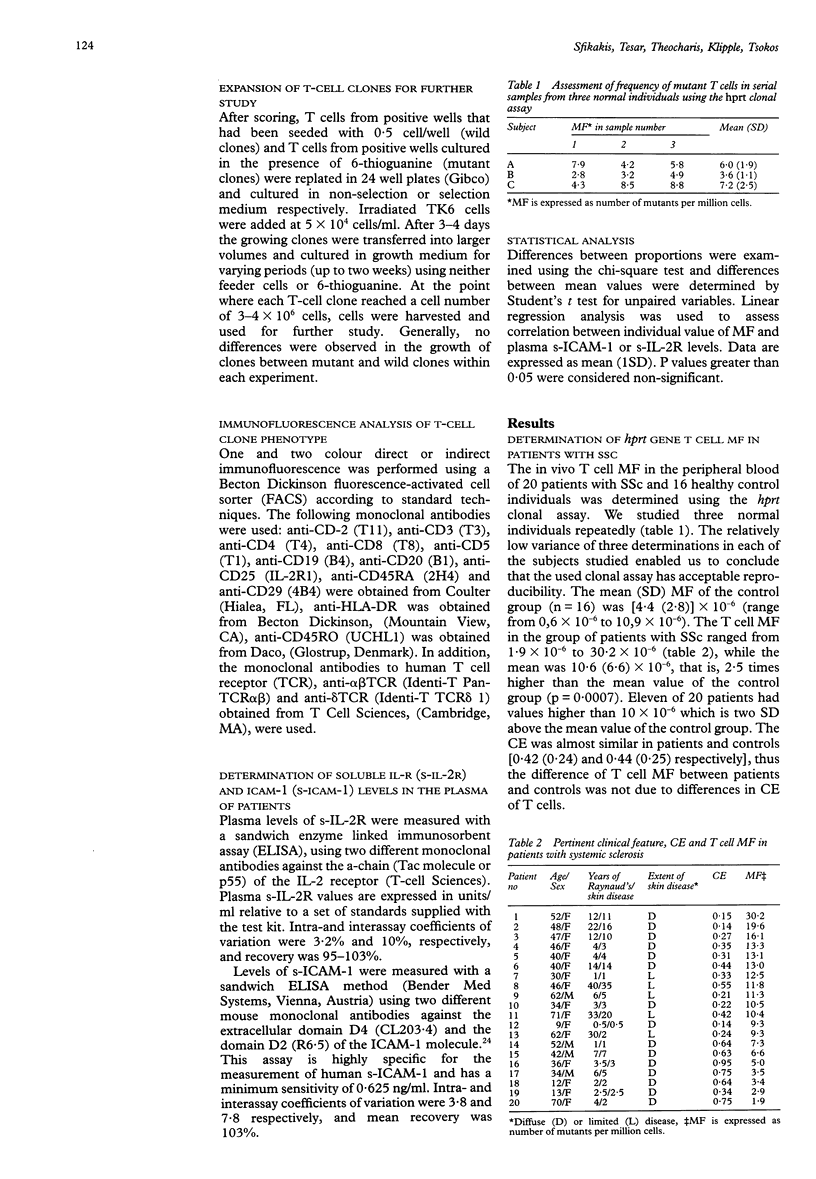
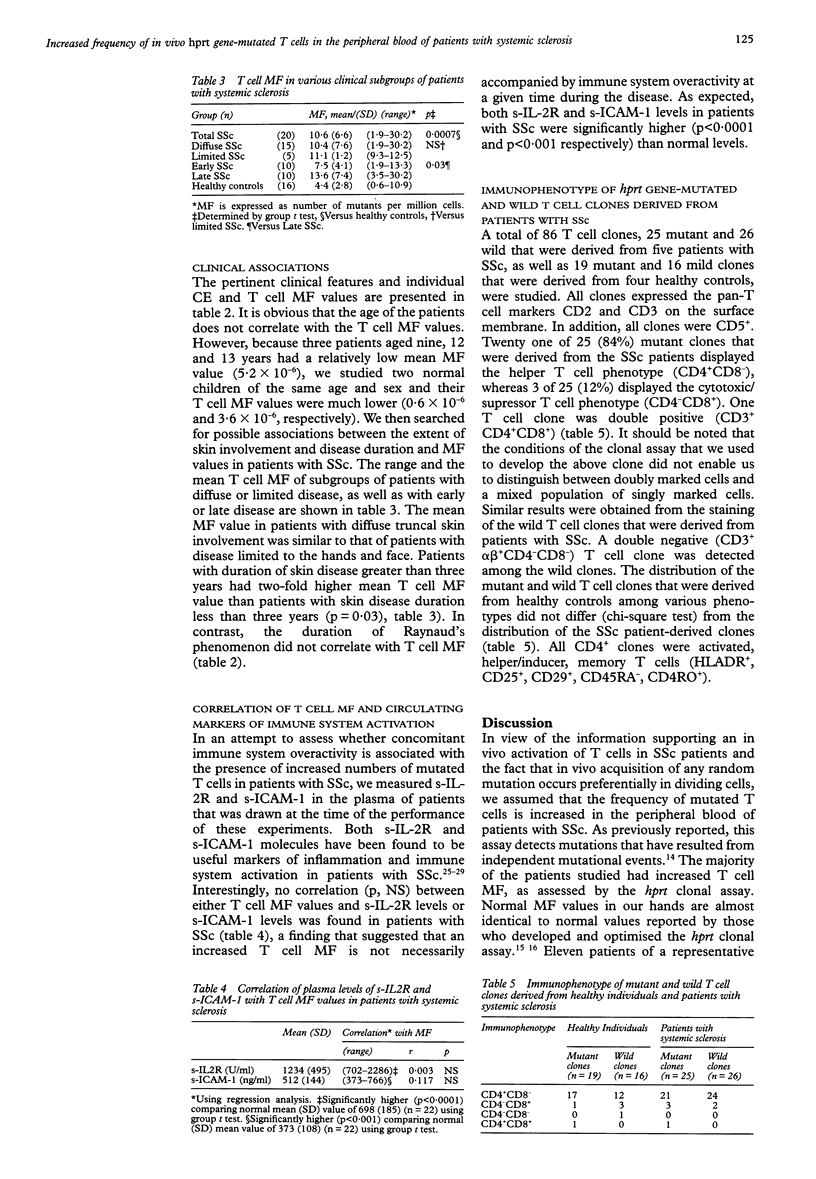
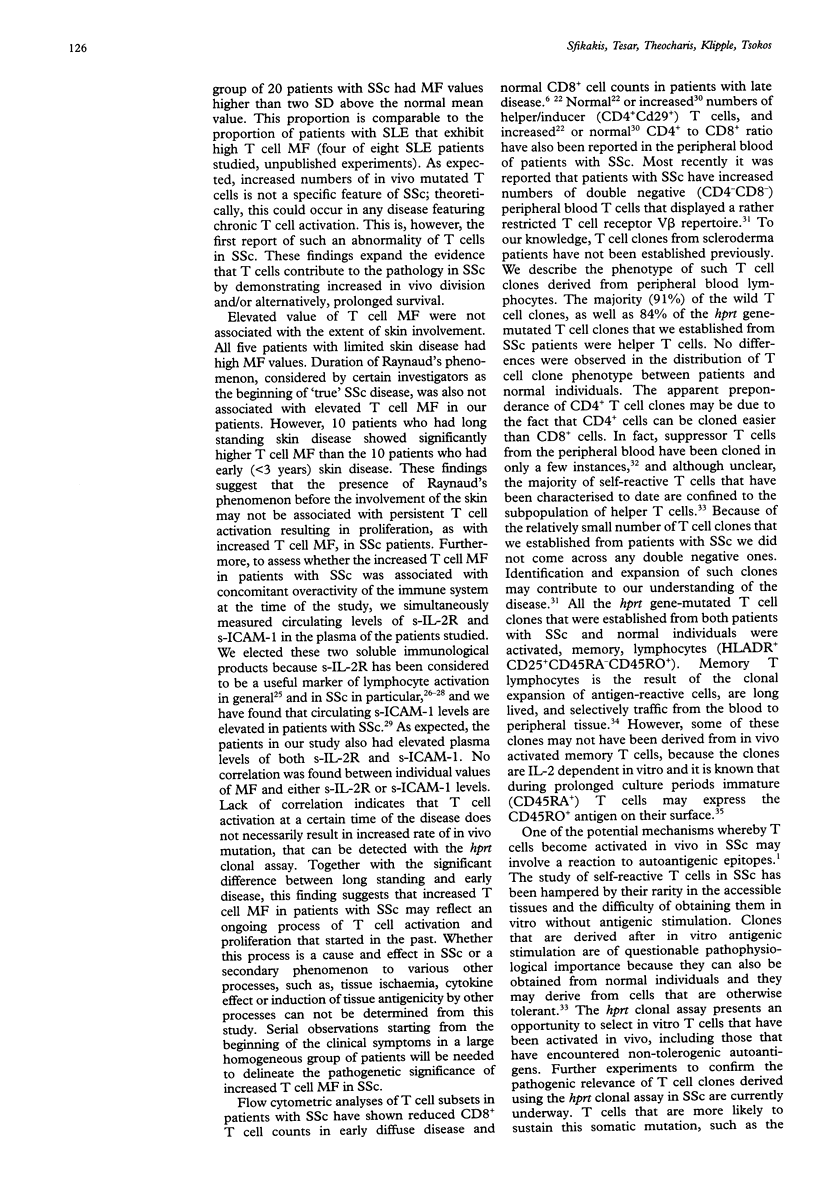
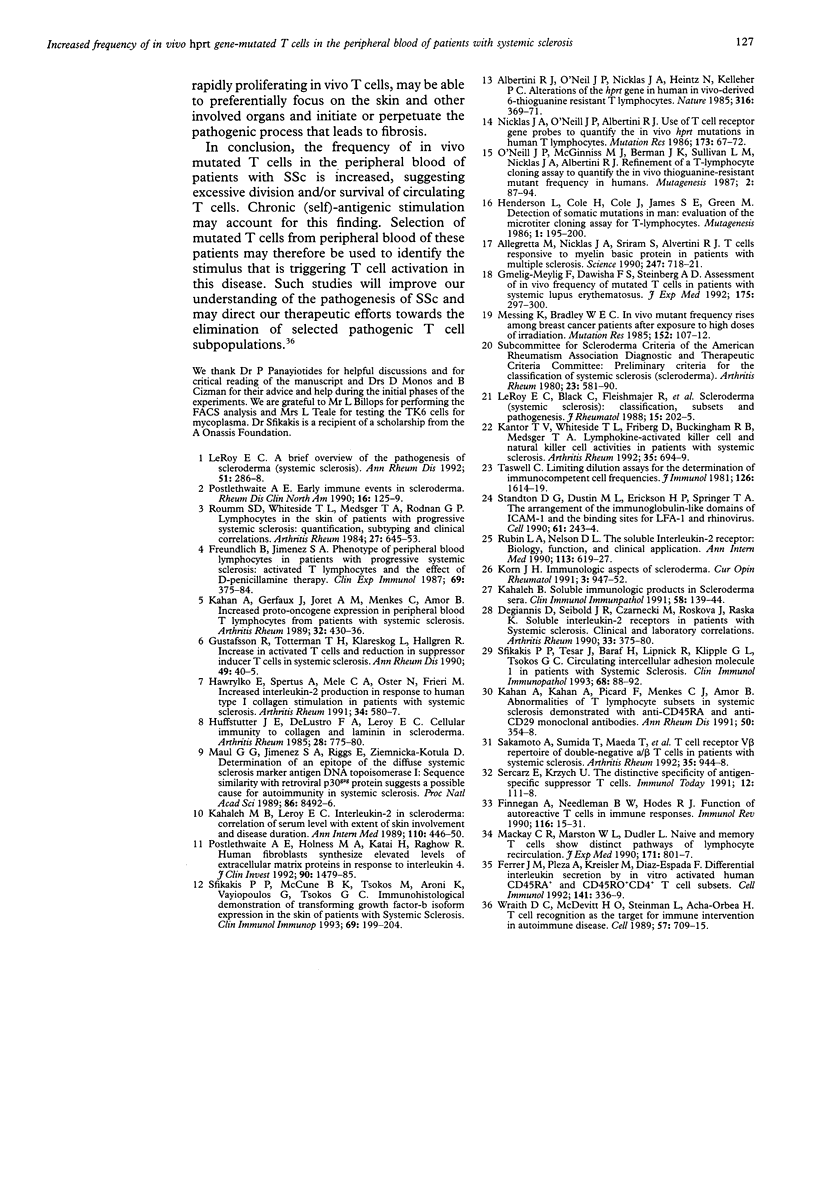
Selected References
These references are in PubMed. This may not be the complete list of references from this article.
- Albertini R. J., O'Neill J. P., Nicklas J. A., Heintz N. H., Kelleher P. C. Alterations of the hprt gene in human in vivo-derived 6-thioguanine-resistant T lymphocytes. Nature. 1985 Jul 25;316(6026):369–371. doi: 10.1038/316369a0. [DOI] [PubMed] [Google Scholar]
- Allegretta M., Nicklas J. A., Sriram S., Albertini R. J. T cells responsive to myelin basic protein in patients with multiple sclerosis. Science. 1990 Feb 9;247(4943):718–721. doi: 10.1126/science.1689076. [DOI] [PubMed] [Google Scholar]
- Degiannis D., Seibold J. R., Czarnecki M., Raskova J., Raska K., Jr Soluble interleukin-2 receptors in patients with systemic sclerosis. Clinical and laboratory correlations. Arthritis Rheum. 1990 Mar;33(3):375–380. doi: 10.1002/art.1780330310. [DOI] [PubMed] [Google Scholar]
- Finnegan A., Needleman B. W., Hodes R. J. Function of autoreactive T cells in immune responses. Immunol Rev. 1990 Aug;116:15–31. doi: 10.1111/j.1600-065x.1990.tb00802.x. [DOI] [PubMed] [Google Scholar]
- Freundlich B., Jimenez S. A. Phenotype of peripheral blood lymphocytes in patients with progressive systemic sclerosis: activated T lymphocytes and the effect of D-penicillamine therapy. Clin Exp Immunol. 1987 Aug;69(2):375–384. [PMC free article] [PubMed] [Google Scholar]
- Gmelig-Meyling F., Dawisha S., Steinberg A. D. Assessment of in vivo frequency of mutated T cells in patients with systemic lupus erythematosus. J Exp Med. 1992 Jan 1;175(1):297–300. doi: 10.1084/jem.175.1.297. [DOI] [PMC free article] [PubMed] [Google Scholar]
- Gustafsson R., Tötterman T. H., Klareskog L., Hällgren R. Increase in activated T cells and reduction in suppressor inducer T cells in systemic sclerosis. Ann Rheum Dis. 1990 Jan;49(1):40–45. doi: 10.1136/ard.49.1.40. [DOI] [PMC free article] [PubMed] [Google Scholar]
- Hawrylko E., Spertus A., Mele C. A., Oster N., Frieri M. Increased interleukin-2 production in response to human type I collagen stimulation in patients with systemic sclerosis. Arthritis Rheum. 1991 May;34(5):580–587. doi: 10.1002/art.1780340510. [DOI] [PubMed] [Google Scholar]
- Henderson L., Cole H., Cole J., James S. E., Green M. Detection of somatic mutations in man: evaluation of the microtitre cloning assay for T-lymphocytes. Mutagenesis. 1986 May;1(3):195–200. doi: 10.1093/mutage/1.3.195. [DOI] [PubMed] [Google Scholar]
- Huffstutter J. E., DeLustro F. A., LeRoy E. C. Cellular immunity to collagen and laminin in scleroderma. Arthritis Rheum. 1985 Jul;28(7):775–780. doi: 10.1002/art.1780280708. [DOI] [PubMed] [Google Scholar]
- Kahaleh M. B., LeRoy E. C. Interleukin-2 in scleroderma: correlation of serum level with extent of skin involvement and disease duration. Ann Intern Med. 1989 Mar 15;110(6):446–450. doi: 10.7326/0003-4819-110-6-446. [DOI] [PubMed] [Google Scholar]
- Kahaleh M. B. Soluble immunologic products in scleroderma sera. Clin Immunol Immunopathol. 1991 Jan;58(1):139–144. doi: 10.1016/0090-1229(91)90155-4. [DOI] [PubMed] [Google Scholar]
- Kahan A., Gerfaux J., Kahan A., Joret A. M., Menkès C. J., Amor B. Increased proto-oncogene expression in peripheral blood T lymphocytes from patients with systemic sclerosis. Arthritis Rheum. 1989 Apr;32(4):430–436. doi: 10.1002/anr.1780320412. [DOI] [PubMed] [Google Scholar]
- Kahan A., Kahan A., Picard F., Menkès C. J., Amor B. Abnormalities of T lymphocyte subsets in systemic sclerosis demonstrated with anti-CD45RA and anti-CD29 monoclonal antibodies. Ann Rheum Dis. 1991 Jun;50(6):354–358. doi: 10.1136/ard.50.6.354. [DOI] [PMC free article] [PubMed] [Google Scholar]
- Kantor T. V., Whiteside T. L., Friberg D., Buckingham R. B., Medsger T. A., Jr Lymphokine-activated killer cell and natural killer cell activities in patients with systemic sclerosis. Arthritis Rheum. 1992 Jun;35(6):694–699. doi: 10.1002/art.1780350615. [DOI] [PubMed] [Google Scholar]
- Korn J. H. Immunologic aspects of scleroderma. Curr Opin Rheumatol. 1991 Dec;3(6):947–952. doi: 10.1097/00002281-199112000-00009. [DOI] [PubMed] [Google Scholar]
- LeRoy E. C. A brief overview of the pathogenesis of scleroderma (systemic sclerosis). Ann Rheum Dis. 1992 Feb;51(2):286–288. doi: 10.1136/ard.51.2.286. [DOI] [PMC free article] [PubMed] [Google Scholar]
- LeRoy E. C., Black C., Fleischmajer R., Jablonska S., Krieg T., Medsger T. A., Jr, Rowell N., Wollheim F. Scleroderma (systemic sclerosis): classification, subsets and pathogenesis. J Rheumatol. 1988 Feb;15(2):202–205. [PubMed] [Google Scholar]
- Mackay C. R., Marston W. L., Dudler L. Naive and memory T cells show distinct pathways of lymphocyte recirculation. J Exp Med. 1990 Mar 1;171(3):801–817. doi: 10.1084/jem.171.3.801. [DOI] [PMC free article] [PubMed] [Google Scholar]
- Maul G. G., Jimenez S. A., Riggs E., Ziemnicka-Kotula D. Determination of an epitope of the diffuse systemic sclerosis marker antigen DNA topoisomerase I: sequence similarity with retroviral p30gag protein suggests a possible cause for autoimmunity in systemic sclerosis. Proc Natl Acad Sci U S A. 1989 Nov;86(21):8492–8496. doi: 10.1073/pnas.86.21.8492. [DOI] [PMC free article] [PubMed] [Google Scholar]
- Messing K., Bradley W. E. In vivo mutant frequency rises among breast cancer patients after exposure to high doses of gamma-radiation. Mutat Res. 1985 Oct;152(1):107–112. doi: 10.1016/0027-5107(85)90051-x. [DOI] [PubMed] [Google Scholar]
- Nicklas J. A., O'Neill J. P., Albertini R. J. Use of T-cell receptor gene probes to quantify the in vivo hprt mutations in human T-lymphocytes. Mutat Res. 1986 Jan;173(1):67–72. doi: 10.1016/0165-7992(86)90013-8. [DOI] [PubMed] [Google Scholar]
- O'Neill J. P., McGinniss M. J., Berman J. K., Sullivan L. M., Nicklas J. A., Albertini R. J. Refinement of a T-lymphocyte cloning assay to quantify the in vivo thioguanine-resistant mutant frequency in humans. Mutagenesis. 1987 Mar;2(2):87–94. doi: 10.1093/mutage/2.2.87. [DOI] [PubMed] [Google Scholar]
- Postlethwaite A. E. Early immune events in scleroderma. Rheum Dis Clin North Am. 1990 Feb;16(1):125–139. [PubMed] [Google Scholar]
- Postlethwaite A. E., Holness M. A., Katai H., Raghow R. Human fibroblasts synthesize elevated levels of extracellular matrix proteins in response to interleukin 4. J Clin Invest. 1992 Oct;90(4):1479–1485. doi: 10.1172/JCI116015. [DOI] [PMC free article] [PubMed] [Google Scholar]
- Roumm A. D., Whiteside T. L., Medsger T. A., Jr, Rodnan G. P. Lymphocytes in the skin of patients with progressive systemic sclerosis. Quantification, subtyping, and clinical correlations. Arthritis Rheum. 1984 Jun;27(6):645–653. doi: 10.1002/art.1780270607. [DOI] [PubMed] [Google Scholar]
- Rubin L. A., Nelson D. L. The soluble interleukin-2 receptor: biology, function, and clinical application. Ann Intern Med. 1990 Oct 15;113(8):619–627. doi: 10.7326/0003-4819-113-8-619. [DOI] [PubMed] [Google Scholar]
- Sakamoto A., Sumida T., Maeda T., Itoh M., Asai T., Takahashi H., Yoshida S., Koike T., Tomioka H., Yoshida S. T cell receptor V beta repertoire of double-negative alpha/beta T cells in patients with systemic sclerosis. Arthritis Rheum. 1992 Aug;35(8):944–948. doi: 10.1002/art.1780350815. [DOI] [PubMed] [Google Scholar]
- Sercarz E., Krzych U. The distinctive specificity of antigen-specific suppressor T cells. Immunol Today. 1991 Apr;12(4):111–118. doi: 10.1016/0167-5699(91)90094-A. [DOI] [PubMed] [Google Scholar]
- Sfikakis P. P., McCune B. K., Tsokos M., Aroni K., Vayiopoulos G., Tsokos G. C. Immunohistological demonstration of transforming growth factor-beta isoforms in the skin of patients with systemic sclerosis. Clin Immunol Immunopathol. 1993 Nov;69(2):199–204. doi: 10.1006/clin.1993.1170. [DOI] [PubMed] [Google Scholar]
- Sfikakis P. P., Tesar J., Baraf H., Lipnick R., Klipple G., Tsokos G. C. Circulating intercellular adhesion molecule-1 in patients with systemic sclerosis. Clin Immunol Immunopathol. 1993 Jul;68(1):88–92. doi: 10.1006/clin.1993.1100. [DOI] [PubMed] [Google Scholar]
- Staunton D. E., Dustin M. L., Erickson H. P., Springer T. A. The arrangement of the immunoglobulin-like domains of ICAM-1 and the binding sites for LFA-1 and rhinovirus. Cell. 1990 Apr 20;61(2):243–254. doi: 10.1016/0092-8674(90)90805-o. [DOI] [PubMed] [Google Scholar]
- Taswell C. Limiting dilution assays for the determination of immunocompetent cell frequencies. I. Data analysis. J Immunol. 1981 Apr;126(4):1614–1619. [PubMed] [Google Scholar]
- Wraith D. C., McDevitt H. O., Steinman L., Acha-Orbea H. T cell recognition as the target for immune intervention in autoimmune disease. Cell. 1989 Jun 2;57(5):709–715. doi: 10.1016/0092-8674(89)90786-1. [DOI] [PubMed] [Google Scholar]


